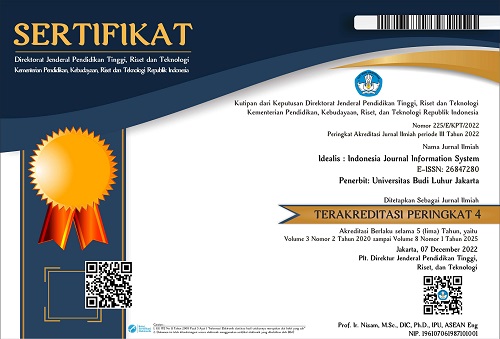PENERAPAN ANALISIS SENTIMEN UJARAN KEBENCIAN TERHADAP VAKSINASI COVID-19 PADA TWEET BERBAHASA INDONESIA MENGGUNAKAN ALGORITME K-NEAREST NEIGHBOR
Abstract
Sistem vaksinasi dengan memanfaatkan media komunikasi dan informasi, tanpa dibatasi oleh kendala waktu, ruang dan tempat serta keterbatasan sistem vaksinasi. Kurangnya kesiapan dalam menerapkan sistem vaksinasi baru tersebut memaksa banyak pihak untuk dapat beradaptasi dalam waktu yang cepat. Sistem vaksinasi yang semula dianggap sebagai solusi mulai menuai beragam pendapat dari masyarakat. Penelitian ini bertujuan untuk melakukan analisis ujaran kebencian pada masa vaksinasi pada media sosial Twitter. Metode yang digunakan adalah dengan melakukan analisis sentimen melalui pendekatan machine learning dengan pelabelan secara manual oleh pakar, dengan ekstraksi fitur menggunakan CountVectorizer dan Algoritme klasifikasi K-Nearest Neighbor. Nilai pengujian dan evaluasi tertinggi yang diperoleh sebesar: akurasi 35%, presisi 20% dan recall 100% menggunakan nilai K=3.
----------------------------------
The vaccination system utilizes communication and information media, without being limited by the constraints of time, space and place as well as the limitations of the vaccination system. The lack of readiness to implement the new vaccination system has forced many parties to adapt quickly. The vaccination system, which was originally considered a solution, has begun to reap various opinions from the public. This study aims to analyze the public's view of the vaccination system on Twitter social media. The method used is to perform sentiment analysis through a machine learning approach with a sentiment dictionary feature, with feature extraction using the CountVectorizer and the K-Nearest Neighbor classification algorithm. The highest test and evaluation values obtained were: 35% accuracy, 20% precision and 100% recall using the value of K=3
Downloads
References
[2] N. Tri Romadloni, I. Santoso, and S. Budilaksono, “Perbandingan Metode Naive Bayes, KNN, dan Decision Tree Terhadap Analisis Sentimen Transportasi KRL Commuter Line,” J. IKRA-ITH Inform., vol. 3, no. 2, pp. 1–9, 2019.
[3] N. O. F. Daeli and Adiwijaya, “Sentiment Analysis on Movie Reviews Using Information Gain and K-Nearest Neighbor,” J. Data Sci. Its Appl., vol. 3, no. 1, pp. 1–7, 2020, doi: 10.34818/JDSA.2020.3.22.
[4] I. Alfina, R. Mulia, M. I. Fanany, and Y. Ekanata, “Hate speech detection in the Indonesian language: A dataset and preliminary study,” 2017 Int. Conf. Adv. Comput. Sci. Inf. Syst. ICACSIS 2017, vol. 2018-January, no. October, pp. 233–237, 2018, doi: 10.1109/ICACSIS.2017.8355039.
[5] U. P. Harapan, “”Hate Speech, Kenapa di ributkan? Ujaran Kebencian (Hate Speech) di Indonesia".” .
[6] A. Masyhur Effendi, Dimensi/Dinamika Hak Asasi Manusia dalam Hukum Nasional dan Internasional. Ghalia Indonesia, 1994.
[7] G. Gunadi and D. I. Sensuse, “Penerapan Metode Data Mining Market Basket Analysis Terhadap Data Penjualan Produk Buku Dengan Menggunakan Algoritma Apriori Dan Frequent Pattern Growth ( Fp-Growth ) :,” Telematika, vol. 4, no. 1, pp. 118–132, 2012.
[8] E. Fitri, N. Zola, and I. Ifdil, “Profil Kepercayaan Diri Remaja serta Faktor-Faktor yang Mempengaruhi,” JPPI (Jurnal Penelit. Pendidik. Indones., vol. 4, no. 1, pp. 1–5, 2018, doi: 10.29210/02017182.
[9] I. Rozi, S. Pramono, and E. Dahlan, “Implementasi Opinion Mining (Analisis Sentimen) Untuk Ekstraksi Data Opini Publik Pada Perguruan Tinggi,” J. EECCIS, vol. 6, no. 1, pp. 37–43, 2012.
[10] L. M. Aiello et al., “Sensing trending topics in twitter,” IEEE Trans. Multimed., vol. 15, no. 6, pp. 1268–1282, 2013, doi: 10.1109/TMM.2013.2265080.
[11] F. V. Sari and A. Wibowo, “Analisis Sentimen Pelanggan Toko Online Jd.Id Menggunakan Metode Naïve Bayes Classifier Berbasis Konversi Ikon Emosi,” J. SIMETRIS, vol. 10, no. 2, pp. 681–686, 2019.
[12] A. V. Sudiantoro et al., “Analisis Sentimen Twitter Menggunakan Text Mining Dengan Algoritma Naive Bayes Classifier,” Din. Inform., vol. 10, no. 2, pp. 398–401, 2018.
[13] T. K. Ronal Watrianthos, Muhammd Noor Hasan Siregar, Dewa Putu Yudhi Ardiana, Dyah Gandasari, Ramen A Purba, Yusra Fadhillah Nur Azizah Affandy, Janner Simarmata, Diena Dwidienawati Tjiptadi, Yo Ceng Giap, Oris Krianto Sulaiman, Noverita Sprinse Vinolina, Deddy, Belajar dari Covid-19 Perspektif Teknologi & Pertanian, vol. ث ققثق, no. ثق ثقثقثق. Yayasan Kita Menulis, 2020.
[14] E. B. Santoso and A. Nugroho, “Analisis Sentimen Calon Presiden Indonesia 2019 Berdasarkan Komentar Publik Di Facebook,” Eksplora Inform., vol. 9, no. 1, pp. 60–69, 2019, doi: 10.30864/eksplora.v9i1.254.
[15] S. N. J. Fitriyyah, N. Safriadi, and E. E. Pratama, “Analisis Sentimen Calon Presiden Indonesia 2019 dari Media Sosial Twitter Menggunakan Metode Naive Bayes,” J. Edukasi dan Penelit. Inform., vol. 5, no. 3, p. 279, 2019, doi: 10.26418/jp.v5i3.34368.
[16] P. Antinasari, R. S. Perdana, and M. A. Fauzi, “Analisis Sentimen Tentang Opini Film Pada Dokumen Twitter Berbahasa Indonesia Menggunakan Naive Bayes Dengan Perbaikan Kata Tidak Baku,” J. Pengemb. Teknol. Inf. dan Ilmu Komput., vol. 1, no. 12, pp. 1718–1724, 2017, [Online]. Available: http://j-ptiik.ub.ac.id.
[17] Munawar, “Sistem Pendeteksi Berita Palsu (Fake News) di Media Sosial dengan Teknik Data Mining Scikit Learn,” 2019. [Online]. Available: https://digilib.esaunggul.ac.id/UEU-Research-16_0402/13322
Copyright (c) 2022 Juan Kalyzta, Muhammad Ardi Willdan, Selfiana Halfiani, Indra Indra

This work is licensed under a Creative Commons Attribution-ShareAlike 4.0 International License.














.png)

